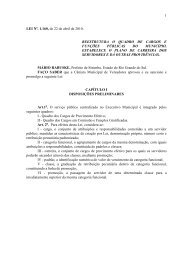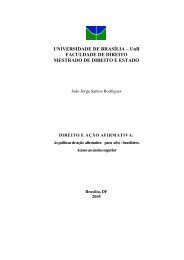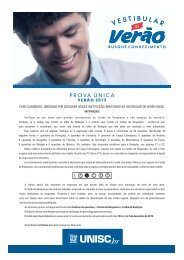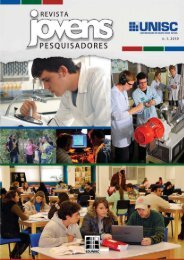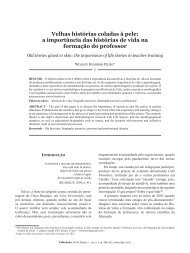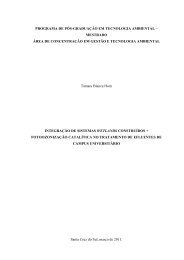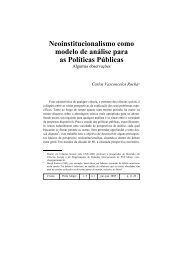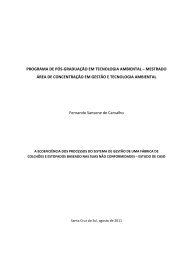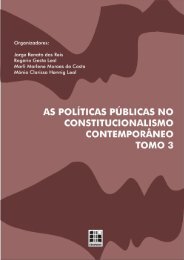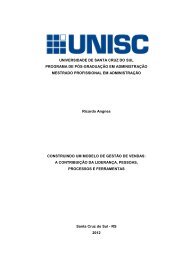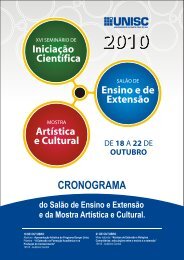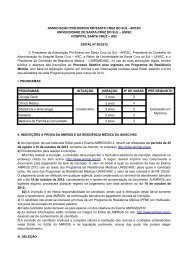PROGRAMA DE PÃS-GRADUAÃÃO â MESTRADO EM ... - Unisc
PROGRAMA DE PÃS-GRADUAÃÃO â MESTRADO EM ... - Unisc
PROGRAMA DE PÃS-GRADUAÃÃO â MESTRADO EM ... - Unisc
Create successful ePaper yourself
Turn your PDF publications into a flip-book with our unique Google optimized e-Paper software.
ABSTRACT<br />
MICROALGAE CULTIVE IN FOTOBIORREATOR AND JOINT REACTOR<br />
OBJECTIVING THE BIOR<strong>EM</strong>EDIATION AND PRODUCTION OF BIOFUELS<br />
This paper aimed to improve the tubular fotobiorreator type bubble column bench<br />
and produce a mixed system for cultivation of microalgae, aiming the bioremediation<br />
and biofuels production. As a way of cultivate it was used the effluent coming from<br />
the Wastewater Treatment Plant – UNISC. To monitor cell density and dry weight, it<br />
was standardized a method using a spectrophotometer (ʎ=682 nm) with a correlation<br />
coefficient R 2 >0,98. In the biomass recovery, it was evaluated the electroflotation<br />
method and it was produced an electrode of iron plates. After improving the<br />
fotobiorreator tubular bench there was an increase in cell density and dry biomass of<br />
approximately 1.80 times. Using the method of enzymatic transesterification in situ, it<br />
was possible to verify all the bioconversion of lipid extracted material that was<br />
confirmed by analysis on HPLC and CG-MS. For the production of ethanol it was<br />
used fungi filamentous concerning the microalgae biomass hydrolysis, followed by<br />
fermentation of Saccharomyces cerevisiae. With the construction of a phototype<br />
system for the mixed culture of microalgae, there has been the development of<br />
various strains of microalgae, achieving maximum cell density of 25.48 x10 6 cells mL -<br />
1<br />
dry biomass of 0,62 g L -1 and lipid percentage of 1.36 % (without contribution of<br />
CO 2 ). Already with CO 2 injection, in 15 days of cultivation, the maximum cell density<br />
was obtained up to 26.97 x 10 6 cells mL -1 , dry biomass 0.72 g L -1 and lipid<br />
percentage of 6.07 %. In assessing the bioremediation of effluent using mixed<br />
system for the cultivation of microalgae without contribution of CO 2 , there was<br />
significant reduction in the parameters of alkalinity, total phosphorus, ammonia<br />
nitrogen and total Kjeldahl nitrogen, however, there was an increase in the DBO 5 and<br />
DQO patterns. With the injection of CO 2 , the results were: alkalinity and DQO<br />
increasing, ammonia nitrogen decreasing, total Kjeldahl nitrogen and DBO 5 In the<br />
last experiment, the phosphorus concentration remained unchanged. Thus, it can be<br />
concluded that the proposed systems are suitable for the production of microalgae,<br />
the bioremediation of waste and the consequent production of biofuel.<br />
KEYWORDS: Microalgae, in situ transesterification, bioethanol, biorremediation.



